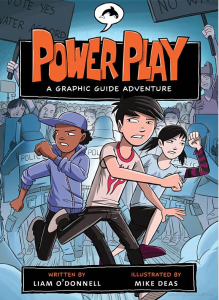As you might know, last week I spoke at the Ontario Library Association’s 2013 Super Conference about my GamingEdus Multi-School Minecraft project. It was a lot fun, definitely exciting and I had a chance to talk Minecraft with many great people. But for me, the real learning I took from OLA didn’t hit me until four days later.
One of the concepts I heard a lot about during the conference was the idea of the library as a ‘learning commons’. It’s a central space that serves as a hub for a wide range of learning activities across grades. On any given day, the place is bustling with primary grade students on the carpet listening to a story, a junior class in the computer lab researching their projects and the ESL instructor playing a game with his small group of students on the smartboard. It’s crowded and often loud, but when it works the place crackles with energy and learning.
The thing that ties together this idea of a learning commons isn’t the age of the learners or the learning being done. It’s the actual physical location of the space. Yesterday, when my students logged into our Multi-School Minecraft server, I realized that the ‘commons’ does not have to exist in a physical, real world space. It can, if conditions are right, happen virtually.
This isn’t anything radically new. Many other educators have already noticed this. But for me, it was the first time I experienced it. And it rocked.
Many Learners, One (Virtual) Space
After lunch yesterday, a small group of my students logged into our Multi-School Minecraft server for the first time. These kids hadn’t played multiplayer Minecraft yet, so were pretty excited to be able to build together and, let’s face it, fight each other. When we logged in, we were pleasantly surprised to see Miss Colby’s students were also on the server. They were on the other side of the map working on their bridge projects, so we couldn’t actually see them. But we knew they were there. In reality, her students were on the other side of the city. My students were like “whatever” and went off exploring. Miss Colby’s kids weren’t too fussed with us being there either. Both groups just went about their play, work and learning.
That’s when it hit me: our server had become a typical “learning commons”.
The only different element was the actual physical location of the learners. This virtual learning commons was a natural space for the learners. They thought nothing of sharing a world with other kids they didn’t know. They do that every day when they log into WeeWorld or whatever game they’re playing these days. For this space to be created within the confines of school and so easily, is what I find interesting and exciting. And it’s just the beginning.
Beyond the Single School Server
With the popularity of Minecraft in education taking off (and we really haven’t seen anything yet), I’m very excited to see so many teachers setting up servers for their classes or creating maps to run their kids through scenarios. However, I think we’re missing another very exciting application of Minecraft. Class servers and lesson maps are cool. But you know what’s really cool?
A shared virtual learning commons that links students from across the city, the country and even the world.
A virtual space with endless real estate that allows for both collaboration and individual work, play and creation. Have a class project with your students? Cool, build it in the learning commons server. Then, when it’s done, invite other classes to check it out. Keep it there as a monument and a model for next year’s class. Each year, new students build on the learning and building of the students before them. Educators themselves connect, share and grow within this space.
For me, this is what is really exciting about Minecraft (and the games to come) in education. I’m happy that so many educators are taking a chance and bringing Minecraft to their schools. I can’t wait for the day when more teachers reach out beyond their schools, their cities, their countries to share, connect, build and learn together.
For me, and my GamingEdus colleagues that day and that server is already here. Our Multi-School Minecraft server connects 30 students, from 3 inner-city schools on 1 single server. We’re looking for more educators to expand our learning commons. If you’re up for it, you can join us.
–-
As an award-winning children’s author, gamer-geek and elementary school teacher, I often have Tech Teaching ideas and project news to share with fellow educators. I deliver these resources and ideas to your inbox in my e-newsletter Reading Change.
If this sounds like something you’d like to receive, then subscribe to Reading Change.
You can unsubscribe anytime and I won’t share or sell your data. Honest.
Thanks!
Liam





















